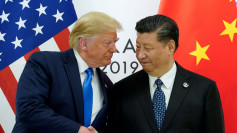China's unrivaled economic boom and the huge hike in energy imports have made the country a key destination for many of the world's biggest exporters of energy.
While it was able to meet its energy quota by generating 4 million barrels per day from its local oil wells 25 years ago, the ratio in 2018 of China's foreign oil reliance hit 70 percent.
This growing level of dependence is a cause for worry for Chinese economic strategists as a looming supply imbalance threatens security. Thus, the state has been urging government-operated energy firms to hike output from local oil rigs to minimize overseas dependence.
China's "Big 3" -- Sinopec, CNOOC, and PetroChina have all risen up to the government's mandate and significantly pumped up their budgets although with mixed results until now.
The country's central government in Beijing has a majority share in the nation's three largest energy conglomerates. PetroChina is the biggest of the three in terms of oil stockpile and gas production.
PetroChina's partial initial public offering in 2007 made it the most valuable energy producer in the world at the time, based on a hypothetical sale of its stocks. The company even beat the psychological threshold of $1 trillion. However, following the global economic turmoil in 2008, PetroChina's market value decreased significantly.
China Petroleum & Chemical Corporation (Sinopec) is the second biggest gas and oil producer in China, and the biggest refiner in Asia. Headquartered in Beijing, the company is listed in Hong Kong and also trades in New York and Shanghai. Sinopec also produces biofuels, ethanol, biodiesel, jet fuel, and even vegetable oil.
Of the Big 3, CNOOC is the smallest but the most methodical. The company enjoys sound profitability as it is not constrained to refinery activities in the capital where regulators pressure the company to cut prices for political reasons. Also, CNOOC has a solid portfolio of offshore projects.
Following a steady pressure from the government, the three energy titans committed to shell out a total of $78 billion or 518 billion yuan in local upstream projects. The market rationale behind this financial infusion is weak considering the maturity of the gas fields and their estimated depletion.
However, China's motive is not to boost the companies' competitive stance, but to lift the country's economy as it faces external frictions and structural obstacles.
Bigger CAPEX goals are providing mixed outcomes for China's energy pillars. While CNOOC and PetroChina have both been able to jack up their oil and gas output by 3.3 and 2.6 percent respectively, Sinopec is lagging behind with a measly 1.5 percent production.






